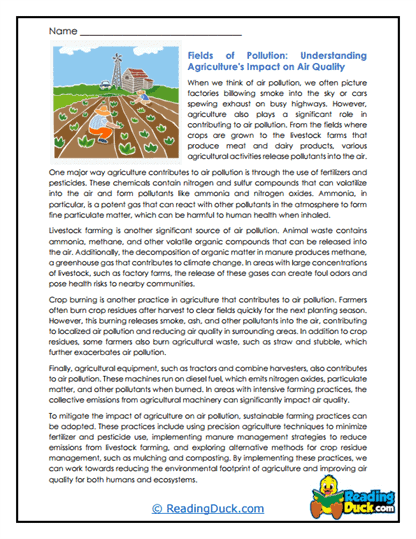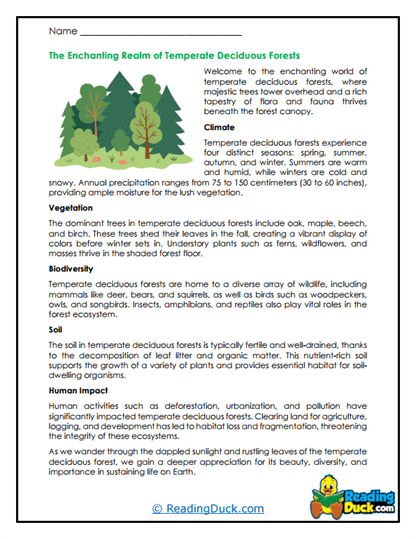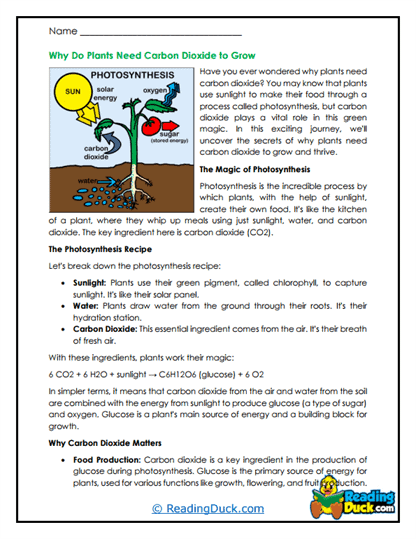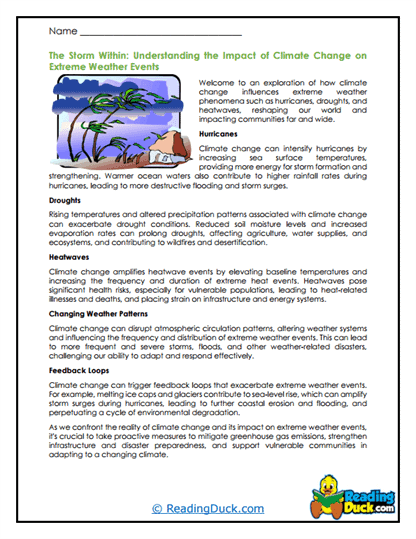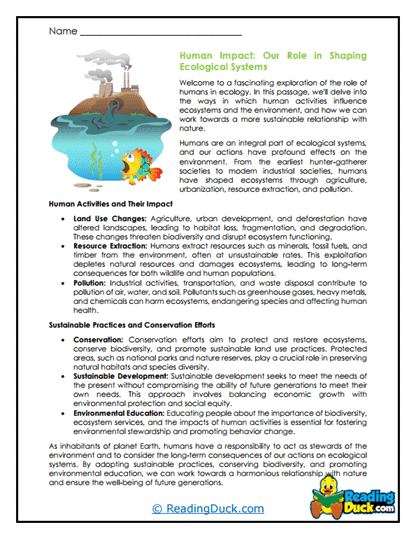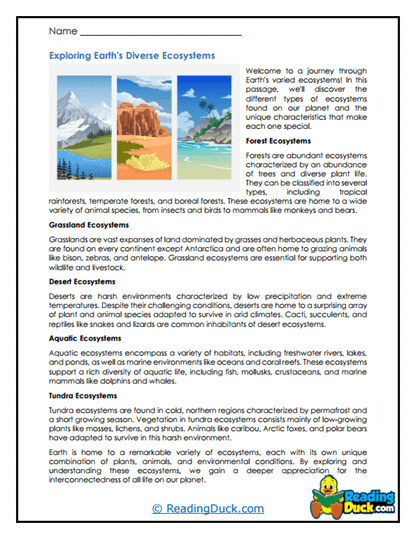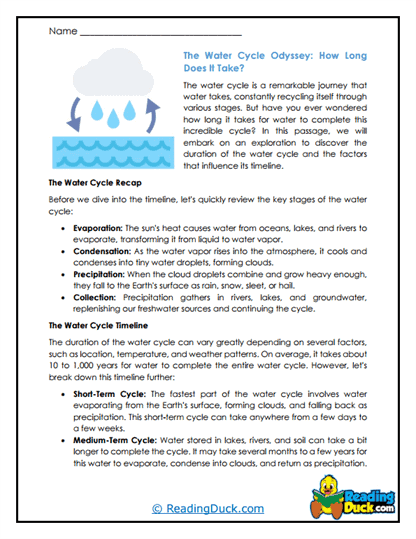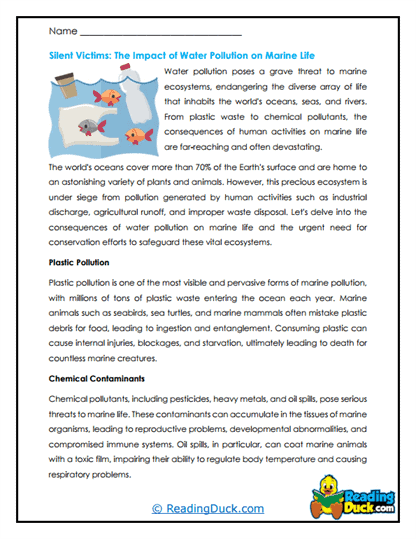Environmental Sciences Worksheets
About Our Environmental Sciences Worksheets
Our collection of Environmental Sciences worksheets offers an engaging and comprehensive exploration into the critical study of the environment, making it an essential resource within the broader category of Science: Biology. Environmental science is a multidisciplinary field that focuses on understanding the complex interactions between the natural world and human activities. This collection is designed to deepen students' knowledge of key environmental topics, such as air pollution, biodiversity, biomes, the carbon cycle, climate change, ecology, ecosystems, the nitrogen cycle, the water cycle, and water pollution.
This collection is a subtopic of Biology and contains several categories, each focusing on a specific environmental theme. These categories contain several worksheet sets. Each worksheet set includes:
- Multiple Choice Questions: These questions assess students' comprehension of the reading passage, ensuring they grasp the key concepts and details presented.
- Short Answer Questions: This section prompts students to write their responses, encouraging them to articulate their understanding in their own words. This exercise helps reinforce their knowledge and improves their ability to communicate scientific information effectively.
- Open-Ended Questions: These questions invite students to share their personal thoughts, opinions, and reflections on the material, fostering critical thinking and allowing them to connect more deeply with the content.
Each worksheet is accompanied by a detailed answer key, making it easy for educators and parents to review students' work. The worksheets are provided in PDF format, ensuring they can be easily viewed electronically, downloaded, and printed.
Exploring Environmental Sciences: A Deep Dive into Our Planet's Health
When introducing students to the topic of environmental science, it's essential to convey the importance of understanding how natural systems function and how human activities impact these systems. Environmental science covers a broad range of topics, each crucial for grasping the interconnectedness of life on Earth and the challenges we face in sustaining it. Here’s a closer look at the key areas covered in this collection:
- Air Pollution: Air pollution is one of the most pressing environmental issues of our time. It involves the introduction of harmful substances into the atmosphere, which can cause health problems for humans, animals, and plants. Students will explore the sources of air pollution, such as industrial emissions, vehicle exhaust, and natural events like wildfires. They will also learn about the effects of pollutants like carbon monoxide, sulfur dioxide, and particulate matter on the environment and public health, as well as the measures being taken to reduce air pollution globally.
- Biodiversity: Biodiversity refers to the variety of life on Earth, encompassing the different species of plants, animals, fungi, and microorganisms, as well as the genetic differences within these species. High biodiversity is crucial for ecosystem stability, resilience, and the provision of ecosystem services. Students will examine the threats to biodiversity, such as habitat destruction, climate change, and invasive species, and the importance of conservation efforts to protect endangered species and ecosystems.
- Biomes: Biomes are large ecological areas on the Earth’s surface, with flora and fauna that have adapted to specific climates and conditions. Examples include deserts, forests, grasslands, and tundras. Each biome has its own unique characteristics and supports different types of life. In this section, students will explore the different types of biomes, their geographical distribution, and the key environmental factors that define them, such as temperature, precipitation, and altitude. They will also learn about the human impact on biomes and the importance of preserving these critical habitats.
- Carbon Cycle: The carbon cycle is the process by which carbon is exchanged between the Earth's atmosphere, oceans, soil, and living organisms. It is a crucial component of Earth's climate system. Students will delve into the steps of the carbon cycle, including carbon dioxide absorption by plants during photosynthesis, carbon storage in fossil fuels, and the release of carbon through respiration, decomposition, and combustion. Understanding the carbon cycle is essential for grasping the impact of human activities, such as deforestation and the burning of fossil fuels, on climate change.
- Climate Change: Climate change refers to long-term shifts in temperature, precipitation, and other atmospheric conditions on Earth. It is primarily driven by human activities, particularly the emission of greenhouse gases like carbon dioxide and methane. Students will explore the science behind climate change, its potential impacts on weather patterns, sea levels, and ecosystems, and the global efforts to mitigate its effects through policies, renewable energy, and conservation strategies. They will also learn about the role of individuals and communities in addressing climate change.
- Ecology: Ecology is the study of interactions between living organisms and their environment. It covers topics such as food chains and webs, energy flow, and the cycling of nutrients within ecosystems. In this section, students will learn about the different levels of ecological organization, from individual organisms to populations, communities, ecosystems, and the biosphere. They will also explore the concepts of ecological niches, competition, symbiosis, and the impact of human activities on ecological balance.
- Ecosystems: Ecosystems are dynamic complexes of plants, animals, microorganisms, and the non-living environment interacting as a functional unit. Ecosystems can be as large as a forest or as small as a pond. Students will study different types of ecosystems, their components, and the interactions that maintain their structure and function. They will also learn about the importance of ecosystem services, such as pollination, water purification, and climate regulation, and the threats to ecosystems posed by human activities like pollution, deforestation, and climate change.
- Nitrogen Cycle: The nitrogen cycle is the process by which nitrogen is converted between its various chemical forms, which is essential for life on Earth. Nitrogen is a key component of proteins and DNA, making it vital for all living organisms. In this section, students will explore the steps of the nitrogen cycle, including nitrogen fixation, nitrification, assimilation, and denitrification. They will also examine the impact of human activities, such as the use of synthetic fertilizers and the burning of fossil fuels, on the nitrogen cycle and the environment.
- Water Cycle: The water cycle, or hydrological cycle, describes the continuous movement of water on, above, and below the surface of the Earth. It includes processes such as evaporation, condensation, precipitation, and runoff. Students will learn about the different stages of the water cycle, the role of water in sustaining life, and the impact of human activities, such as urbanization and pollution, on the natural flow of water. They will also explore the importance of water conservation and the challenges of managing water resources in a changing climate.
- Water Pollution: Water pollution occurs when harmful substances, such as chemicals, waste, and microorganisms, contaminate water bodies like rivers, lakes, and oceans, making them unsafe for human use and damaging to aquatic life. In this section, students will examine the sources of water pollution, including industrial discharges, agricultural runoff, and plastic waste. They will also explore the effects of water pollution on ecosystems and human health, as well as the strategies being implemented to reduce and prevent pollution.
By exploring these key areas of environmental science, students will gain a comprehensive understanding of the complex interactions that sustain life on Earth and the challenges we face in preserving these systems. These worksheets will guide students through the fundamental concepts of environmental science, encouraging them to think critically about the impact of human activities on the planet and the actions we can take to protect our environment.
Using These Worksheets in School or Homeschool
Integrating our Environmental Sciences worksheets into a school or homeschool curriculum offers numerous opportunities to enhance students' understanding of the natural world and the pressing environmental issues of our time. Here are some practical and creative ways to effectively use these worksheets in various educational settings:
- Thematic Units on Environmental Science: Use these worksheets as part of a comprehensive unit on Environmental Science. For instance, you could dedicate each week to a different topic, such as Air Pollution or the Water Cycle. Start with a reading passage to introduce the topic, followed by the comprehension questions to assess understanding. This structure allows students to build a strong foundation in each area, gradually deepening their knowledge as they progress through the unit.
- Project-Based Learning: Encourage students to undertake a project related to one of the environmental topics covered in the worksheets. For example, after studying Climate Change, students could research the impact of climate change on a specific region or species and present their findings to the class. These projects can be multidisciplinary, incorporating science, geography, and even social studies, as students explore how environmental issues affect communities around the world.
- Interactive Group Activities: Organize group activities where students collaborate to complete the worksheets. For example, in a study of ecosystems, students could work in small groups to research different types of ecosystems and then present their findings, using the worksheets as a guide. This collaborative approach fosters teamwork and allows students to learn from one another while deepening their understanding of complex environmental systems.
- Field Trips and Experiential Learning: Reinforce the concepts learned in the worksheets by organizing field trips to local natural areas, water treatment plants, or environmental research centers. For instance, after studying Water Pollution, a visit to a nearby river or lake can help students observe the effects of pollution firsthand and discuss real-world applications of what they’ve learned. If in-person field trips are not feasible, consider virtual tours or online simulations that allow students to explore environmental issues in a different format.
- Cross-Curricular Connections: Environmental Science is inherently interdisciplinary, so these worksheets can be integrated across different subjects. In an English class, students could write essays or reports on topics like Biodiversity or Climate Change, using the information from the worksheets as a starting point. In art class, students could create posters or visual representations of the Carbon Cycle or Biomes, reinforcing their understanding through creative expression.
- Homework Assignments: Assign the worksheets as homework to reinforce classroom learning. This approach gives students the opportunity to engage with the material independently and at their own pace. They can complete the reading passage and questions at home, then bring their completed work back to class for discussion. This method helps reinforce key concepts and encourages students to take ownership of their learning.
By incorporating these Environmental Sciences worksheets into the curriculum, teachers and parents can provide students with a thorough and engaging learning experience. These worksheets are designed to help students explore the critical topics in environmental science, develop essential skills in reading comprehension and critical thinking, and foster a lifelong interest in the health and sustainability of our planet. Whether used in the classroom or at home, these resources will inspire students to appreciate the intricate balance of the natural world and understand the importance of protecting it for future generations.
